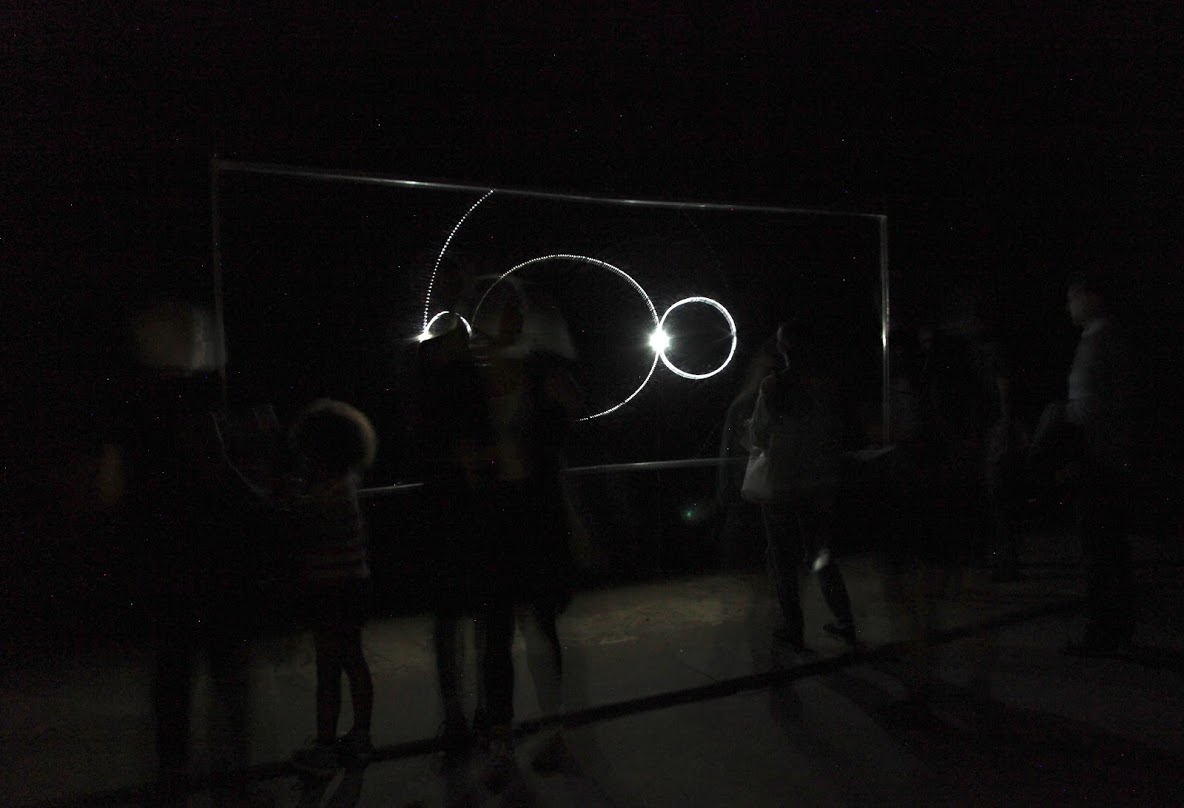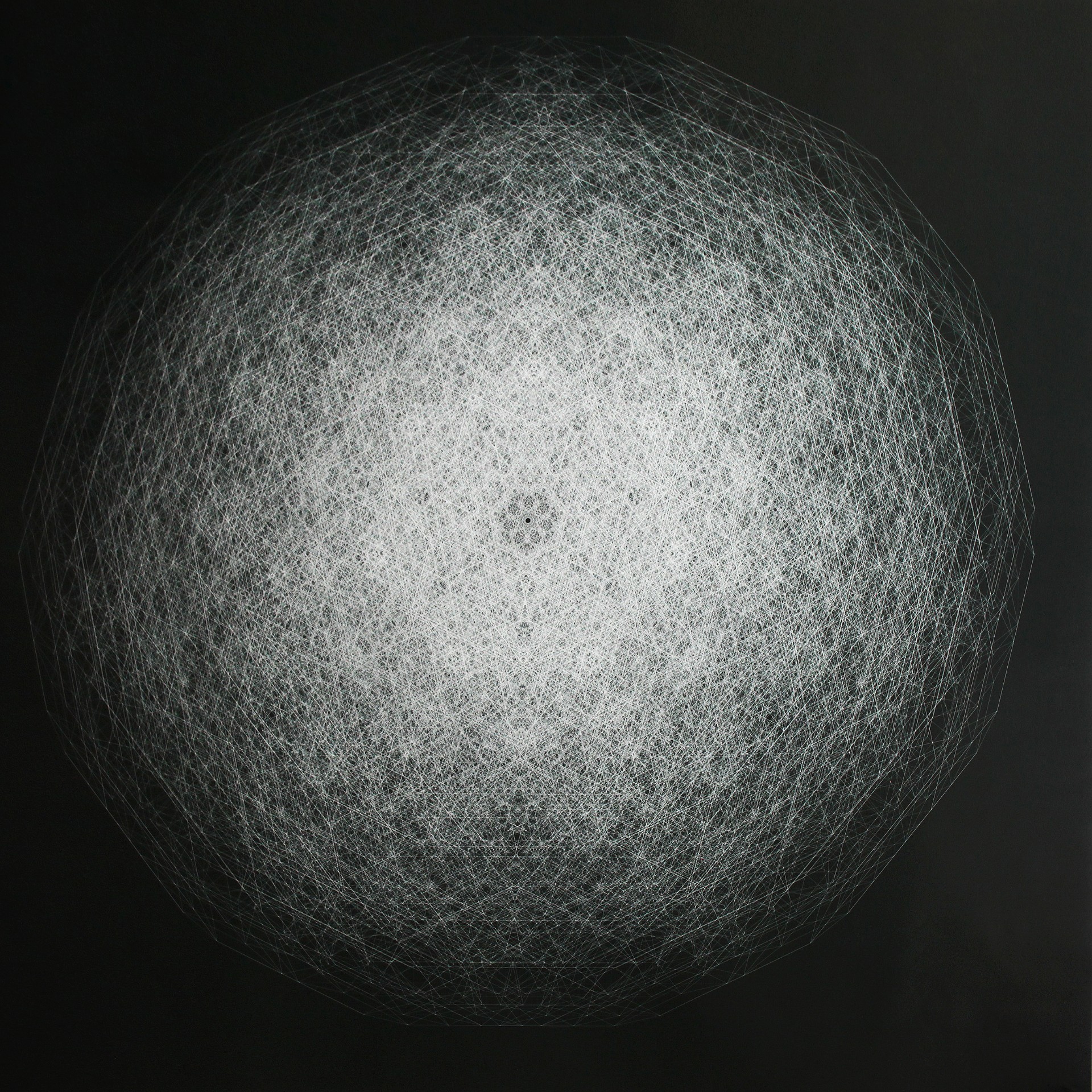Your Country Of Two Dimensions Is Not Spacious Enough.
LIMITS OF PERCEPTION LAB

Sommersonnenwende–INVOCATIONS 21.06.2020 18:00
MIT Taita Juan Martín Jamioy Juajibio, Juan-Andres Leon, Sangeetha Menon, Ida Momennejad, Monica Narula, Arlette Ndakoze, Sunčica Ostojić, Lisa Randall, Tomas Saraceno, Elisabeth Tambwe & das LAB team
Über Unsere Facebook-Seite
On the evening of the summer solstice, Ivana Franke and the curators of the LIMITS OF PERCEPTION LAB gather in the artist’s studio to connect with thinkers, scientists, philosophers of mind, and artists spaced at different latitudes and time frames to ponder the limits of our perception and navigate us into the extra dimensions of spacetime. On the longest and most luminous day of the year, under different skies and across disciplinary boundaries, artist Monica Narula (Raqs Media Collective), physicist Lisa Randall, philosopher of mind Sangeetha Menon, historian of science Juan-Andres Leon, shaman Taita Juan Martín Jamioy Juajibio, neuroscientist Ida Momennejad, curator Sunčica Ostojić, and artists Tomas Saraceno and Elisabeth Tambwe will deliberate with Ivana Franke, Arlette Ndakoze, Elena Agudio, Kelly Krugman and Israel Lopez on the possibility of thinking beyond the pervasive but quite possibly mistaken assumption that we live in a three-dimensional world. In an online performative and extra-disciplinary conversation, the participants will grapple with the possibility of cracking with some of our preconceived ideas of reality, lending it other dimensions that are decidedly of the otherwise, imaginary, and cosmic, and with SAVVY Contemporary’s investigation on the role of science in modern societies and its pretensions to objectivity, rationality, and universal truth.
Schedule
18:00 | Introduction by curator Elena Agudio |
18:10 | Monica Narula |
18:25 | Lisa Randall |
| 18:40 | Ivana Franke |
| 18:50 | Sangeetha Menon |
19:05 | Juan-Andres Leon |
19:20 | Discussion Limits of Perception Lab Team (Ivana Franke, Elena Agudio, Kelly Krugman, Israel Lopez) |
19:35 | Taita Juan Martín Jamioy Juajibio with Israel Lopez |
19:50 | Ida Momennejad |
| 20:05 | Interlude with the Limits of Perception Lab Team |
| 20:15 | Elisabeth Tambwe |
20:20 | Sunčica Ostojić |
20:35 | Tomas Saraceno |
| 20:45 | Discussion with the Limits of Perception Lab Team, Arlette Ndakoze, and Juan-Andres Leon |
| Moderation by Elena Agudio |
Participants
Juan-Andres Leon studied Physics and History in Colombia, before completing his PhD in the History of Science at Harvard University. For the past four years, he has been living in Berlin while co-writing a book on the history of German astronomy and astrophysics in the second half of the 20th century. He works at the intersection between the physical sciences, political, and environmental issues.
Parallel to his academic production, Juan-Andres has worked at several museums with an interest in modern scientific instrumentation and computing.
Juan-Andres inquires on how knowledge is produced within large science organizations such as the Max Planck Society, as well as international scientific initiatives such as Atoms for Peace, CERN, and a multitude of astronomical observatories. All these contribute insights regarding the ongoing globalization of scientific research and its role in the Anthropocene.
Sangeetha Menon is Dean of the School of Humanities at the National Institute of Advanced Studies, in the Indian Institute of Science campus, in Bangalore, India. At NIAS she is the professor and head of the Consciousness Studies Programme. Dr Menon has been working in the area of consciousness studies for over twenty years. She has given numerous lectures and presentations in her country and also in the United States, Europe and Australia on wide-ranging issues relating to consciousness, mind, and science-spirituality interface issues. Her publications cover areas that concern consciousness studies, brain sciences, altruism, aesthetics, Indian psychology and science-spirituality-art dialogues. Her latest books published include: “Brain, Self and Consciousness: Explaining the conspiracy of experience”; and the edited volume “Interdisciplinary Perspectives on Consciousness and the Self”; “The Beyond Experience: Consciousness in Bhagavad Gita”, to name a few.
Ida Momennejad is a cognitive computational neuroscientist at Columbia University, Electrophysiology, Memory, and Navigation Lab. She was previously a postdoc at Princeton, where she collaborated with Ken Norman, Matt Botvinick, Jon Cohen, and Nathaniel Daw. Her PhD was in psychology (Berlin, Germany, Haynes lab), BSc in software engineering (Tehran, Iran), & MSc in Philosophy of Science (Utrecht, Netherlands).
She studies how memory and planning rely on learning relational structures. She shows that multi-scale predictive maps updated via memory replay support abstraction and hierarchical planning. She combines behavioral experiments, fMRI, and electrophysiology with reinforcement learning, neural networks, and machine learning.
In another line of research she uses graph theory, experiments, and multi-agent simulations to study how conversational networks shape collective memory and other collective behavior (see Computational Justice).
Monica Narula formed Raqs Media Collective in 1992, along with Jeebesh Bagchi and Shuddhabrata Sengupta. The word “raqs” in several languages denotes an intensification of awareness and presence attained by whirling, turning, being in a state of revolution. Raqs Media Collective take this sense to mean ‘kinetic contemplation’ and a restless and energetic entanglement with the world, and with time. Raqs practices across several media; making installation, sculpture, video, performance, text, lexica and curation. The members of Raqs Media Collective live and work in Delhi, India. In 2001, they co-founded the Sarai program at CSDS New Delhi and ran it for a decade, where they also edited the Sarai Reader series. They are developing sources around toxicity, care, and luminosity of friendship with artists, and publics, for the forthcoming Yokohama Triennale (2020).
Sunčica Ostoić has a degree in art history and philosophy from the Faculty of Humanities and Social Sciences, University of Zagreb. In 2002 she co-founded NGO KONTEJNER / bureau of contemporary art praxis, where she has worked as curator. Currently she is a Ph.D. candidate in transdisciplinary studies of contemporary art and media at the Faculty of Media and Communications in Belgrade. Her interests cover the field of the theory and practice of extreme, extravagant and radical art in the twenty-first century. She is a guest lecturer at the Academy of Fine Arts in Zagreb (“Art at the intersection of science and technology”).
Lisa Randall studies theoretical particle physics and cosmology at Harvard University. Her research connects theoretical insights to puzzles in our current understanding of the properties and interactions of matter. She has developed and studied a wide variety of models to address these questions, the most prominent involving extra dimensions of space. Her work has involved improving our under-standing of the Standard Model of particle physics, supersymmetry, baryogenesis, cosmological inflation, and dark matter.
Professor Randall earned her PhD from Harvard University and held professorships at MIT and Princeton University before returning to Harvard in 2001. She is also the recipient of honorary degrees from Brown University, Duke University, Bard College, and the University of Antwerp.
Tomás Saraceno moves in his practice toward the entanglement of diverse threads of thought, including art, life science and the social sciences. Enmeshed at the junction of these worlds, his floating sculptures, community projects and interactive installations propose and explore new, sustainable ways of inhabiting and sensing the environment.
Taita Juan Martín Jamioy Juajibioy inherited the shamanic tradition of healing from his mother, a healer and midwife, who came from a long line of shamans. She belongs to the Kamentsa Biyá tribe in the Sibundoy Valley in Putumayo, Colombia.
Taita Juan Martín Jamioy was introduced to the Yagé tradition as a child. He began taking the medicine at the age of 8, at the age when children in his tribe are initiated. His mother says that he fell into the Putumayo River as a child, she found him floating in the water, his body lifeless. He was lying in a bed in the cabin, it was raining outside. Suddenly the thunder shook the whole house and the child came back to life. The force of nature appointed him, he had an important task to fulfill.
At the age of 20, when he was a young man, he already cooked his own Yagé and only a few years later he followed his vocation to become a shaman, a man of knowledge, or Taita, as they are called in Colombia. He found a grandfather, a wise man, a master who taught him the ancient wisdom of Amazon shamanism. In the depths of the jungle he learned the secrets of the Yagé to help others. People came to him for healing and counseling. The path of medicine led him to work for the indigenous peoples. He represented his people in an indigenous organization until he became an active member of ONIC (Organización Nacional Indígena de Colombia), an organization that represents indigenous peoples in Colombia politically. Taita Juan was appointed representative of traditional medicine.
In this context Taita Juan had to move to Bogotá, where he continued to share medicine with people seeking help in the urban environment.
KuratorIn Elena Agudio
Kokuratorin Kelly Krugman
Künstlerische Leitung Bonaventure Soh Bejeng Ndikung
Produktion Kimani Joseph
Management Lema Sikod
KommuniKation Anna Jäger
Live-Stream Boiling Head Media
Lab–Mitarbeiter*innen Israel Lopez, Dora Sribar
Förderung Das Projekt wird vom Kultusministerium der Republik Kroatien, im Rahmen der Kroatischen EU-Ratspräsidentschaft, gefördert.
Photo Ivana Franke. From the Faraway



